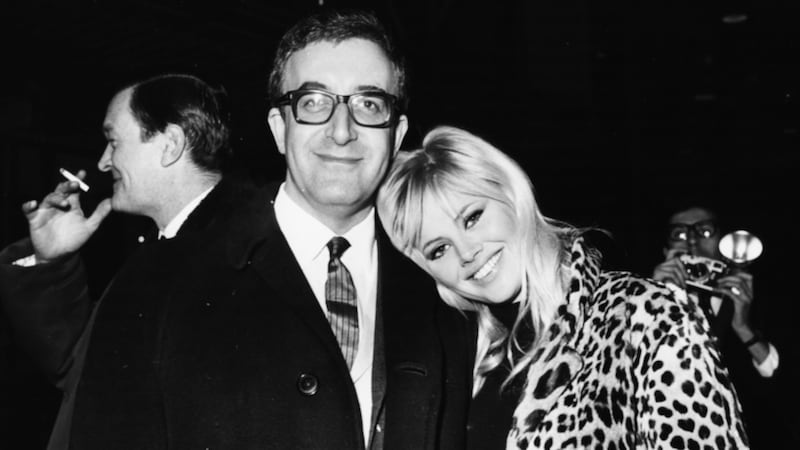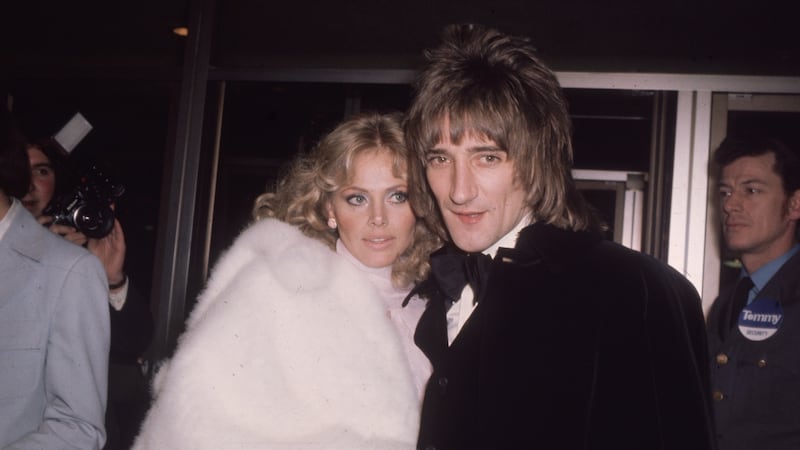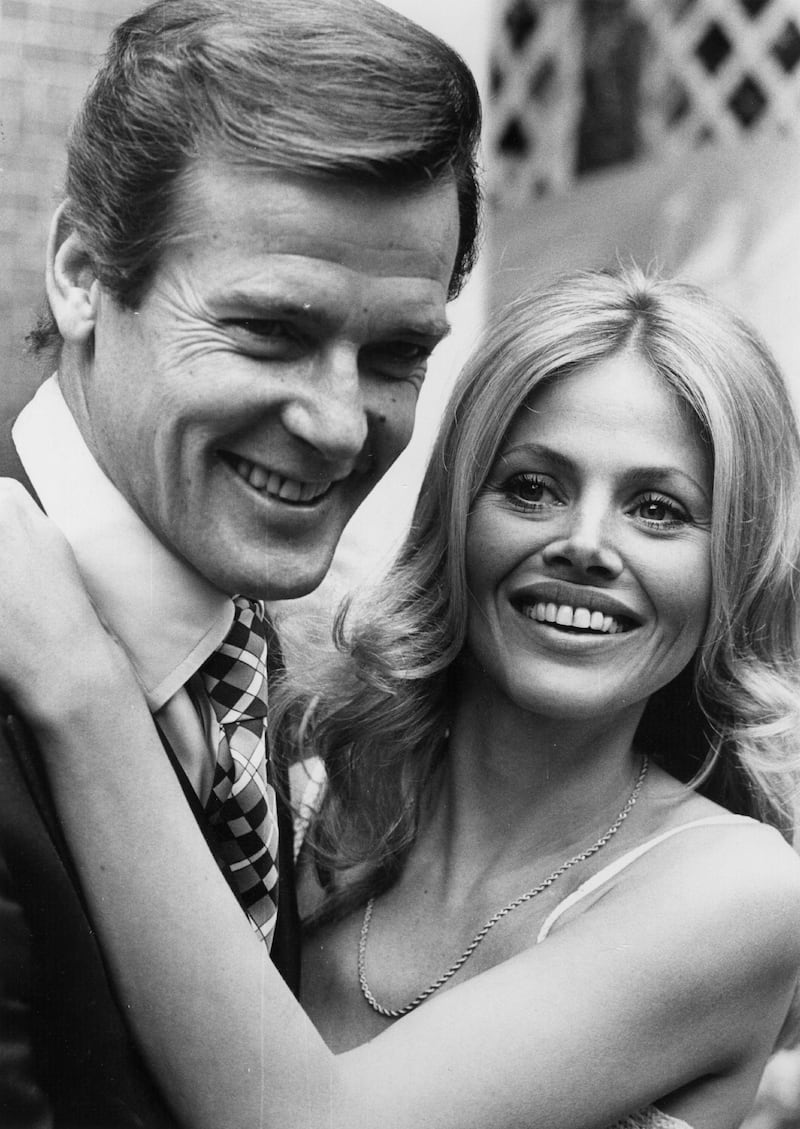Two days after their first date – which was also their first meeting – the comedian Peter Sellers gave Britt Ekland a dachshund puppy called Pepper.
Ekland had just arrived in London from Sweden to be 20th Century Fox's next big star. She was 21 years old and living at the Dorchester hotel; a dog was a ridiculous gift, she says. So was Sellers's previous largesse – every bloom in the hotel's flower shop. "That was the way he wooed me."
Just 10 days after their first date, Ekland and Sellers – 17 years her senior – were married, and the puppy was lost in the whirlwind. “All these years, I always wondered: what happened to Pepper?” says Ekland, now 77. Two weeks ago, she found out. A woman wrote to Ekland’s agent, saying she had taken Pepper, and that he lived a “long and happy life”. Ekland sighs, audibly relieved.
Although she lives mostly in Sweden and Los Angeles, Ekland was in the UK touring in the play The Cat and the Canary when the coronavirus hit. She is coping well in lockdown in London, walking her dog and cleaning. But, as a "totally nonessential worker", life has slowed dramatically.
Ekland's career began when she was a teenager, appearing in chewing gum adverts and doing modelling jobs. She would go on to become one of the most-photographed women of the 1970s: as Sellers's young bride, Roger Moore's Bond girl in The Man With the Golden Gun and in high-profile relationships with the record exec Lou Adler and rock stars Rod Stewart, Phil Lewis and Slim Jim Phantom.

That she remains so prolific today – a fixture of reality television, talkshows and the panto circuit – is down to her work ethic. “If you want publicity, you’ve got to do something to deserve publicity,” she says. Even since lockdown began, she has appeared in BBC One’s The Real Marigold Hotel (where a group of older celebrities live out a retirement fantasy in India) and in the BBC Two documentary Peter Sellers: A State of Comic Ecstasy, about the comedian’s mental health problems, and his alcohol and substance misuse. That Ekland is still best known as Sellers’s former wife is testament to the star power – and infamous intensity – of their pairing.
They met in January 1964 after Sellers saw Ekland’s photograph in the newspaper and sent his valet round to her room. As he put it once: “I thought that I would like to meet what I saw.”
Ekland knew his name only from gossip magazines as a beauty pageant judge who had reportedly tried it on with Miss Sweden. She wore "a lot" of clothes to go to his suite, she says wryly. She thought Sellers worldly and suave, but she "didn't have a clue" about his career. When Sellers realised, he suggested a trip to the cinema – to see The Pink Panther, in which he played Inspector Clouseau. "This wasn't about you telling him about yourself," says Ekland. "This was about him telling you."
His marriage proposal, if you can call it that, was similarly brazen. About a week after they met, Ekland left for New York. Sellers called her. “He said: ‘I’ve told the press we’re getting married. Is that OK with you?’ I didn’t know what to say. Even to this day, I don’t know what I said.”
Ekland says she wasn't the type to look for red flags. She describes herself as wilful and "extremely impulsive … I'm like a steamroller – I just go forward. I don't have that stopper in me … Someone falls down in front of me, then I fall in love with him." As a teenager in Stockholm, she "fell in love every five seconds", once writing in her diary in blood while playing Tchaikovsky's Swan Lake. "You had a bit of a snog, then it was over, so you wrote in blood," Ekland says pragmatically, when I bring it up.
Her father was delighted when she married Sellers, despite the age gap. “Fame overcomes a lot of things,” she says drily. Not that he could have stopped her. She was “deliriously happy”, “madly in love” and soon to be a big star.
Then, she says: “It all came crashing down.” Days after their wedding, Sellers flew to Los Angeles for a film and sent her a three-page letter obsessing that she might leave him or be unfaithful, and saying he wanted to have “violent” sex with her. It was signed with 25 kisses.
Sellers urged Ekland to join him for Easter, waving away her commitments to shoot the film Guns at Batasi. She acquiesced. Within days of her arrival in Los Angeles, he had the first of a series of heart attacks. “By the following Sunday, he was on life support.” Ekland’s parents flew out to join her, and she learned to drive between Sellers’ mansion and the hospital. “I prayed to God a lot, even though I’m not a religious person … just hoping and believing that he would pull through.” He did, and their daughter Victoria was born in January 1965.
By then, Ekland had been fired by Fox for breach of contract for leaving Guns at Batasi, and knew about Sellers’ dark side. In company, he was “the joker, the fabulous comedian”, she says sarcastically. “He kept the table going for hours … everyone loved him: ‘Such a fun evening!’” The question she has been asked most in her life is: “How fun was Peter Sellers at home?”
In truth, he was “very possessive and very, very moody”. He would threaten Ekland with divorce, then just as capriciously make up, and fly into jealous rages. The abuse was never physical – if it had been, Ekland says she “might have left sooner … I know that sounds horrible. [but] I’m just being practical.” Did she see the relationship as abusive at all? She hesitates. “Well, I realised it wasn’t right – someone putting me through emotional and psychological warfare.”
Once, Hugh Hefner told Sellers he had nude pictures of Ekland as a ploy to get Sellers, a keen photographer, to supply some himself. Ekland, who was always "very prudish", knew it was a bluff. "I never purposely posed half-naked." Even shooting films, she would cover herself up with black camera tape – "however painful it was to take off". She scoffs to hear herself described as a sex symbol. "I don't know what a 'sex symbol' is."
Sure enough, Hefner’s smoking gun showed Ekland with scarcely a bare shoulder. But Sellers had not believed her. “It was just horrifying that he should accuse me of something that was so very far from who I was.”

No fight was too petty, says Ekland. "If I spoke to my mother in Swedish, that would be a huge rant for hours, like this …" She mimics an unintelligible, screeching tirade. "He never took a pause." Ekland confided in the actor Nanette Newman and her husband, the director Bryan Forbes – the couple's closest friends in Hollywood. "One night, I just got in the car and drove to them to seek shelter … this continued throughout my marriage."
It all ended as abruptly as it began. After dinner at the Excelsior hotel in Rome, Ekland permitted the paparazzi to take their photograph, enraging Sellers. In their room, his “high-pitched waffling” went on all night, prompting noise complaints.
“Eventually, at 5am, I’d been so traumatised, I couldn’t take any more,” says Ekland. (Some accounts say she took a Valium.) “And he suddenly just said: ‘That’s it. You’re out of here.’” Sellers called the couple’s agent, who took Ekland to another hotel nearby, “where I hid until I got the flight to Sweden”. There she was reunited with Victoria, then about five, who had been in the UK with her nanny.
Sellers made several efforts to reconcile, but, says Ekland: “I knew that this was it – I’d had enough.” Only someone “mentally super-strong” could have withstood four years, she adds. They divorced in December 1968.
Sellers died of a heart attack in 1980. Although he was never diagnosed, Ekland believes him to have had bipolar disorder. Though she has disputed accounts of Sellers’ alcohol and cocaine dependency, she told the recent BBC Two documentary that he was unable to get help for his mental health problems “because he was such a valuable asset”.

Ekland has only ever sought help for her mental health once – in the 1980s, after her mother died of Alzheimer’s aged 78. Although she disliked her father, she and her mother were very close. “Wherever I worked, she always came.” Ekland was prescribed antidepressants after her loss, but stopped taking them after three days.
She is used to getting on with things. "I am so used to taking care of myself, I don't need anyone to do anything for me." Her most recent marriage, to the Stray Cats drummer, Slim Jim Phantom, ended after eight years in 1992. After three children by three partners, Ekland was preaching "self-partnership" long before Emma Watson, back when there really was a stigma.
“I’ve always been a modern woman, and I still am,” says Ekland now. That said, she is scathing of some modern women – specifically, social media influencers. Without naming names, she says she pities “those poor Plasticine models … throwing themselves explicitly over their Instagrams. All that effort, for such little payback.”
Even Bond girls do not make the same impact today, says Ekland. “I’m the proudest Bond girl there is because there are not a lot of us left, and there won’t be any in future.” She has said modern Bond girls have it harder than she did, there now being “so many demands” – she believes, imposed by political correctness.
"The Bond girl has to look good in a bikini: that was her role … The Bond girl of my era exists no more because they're not presented that way. You wouldn't see her in a bikini next to Daniel Craig in a suit today – the PR department would make sure that didn't happen."
Ekland also brushes off beauty standards as a factor in her historical embrace of cosmetic surgery. Once outspoken in her praise of it for over-40s (“I think it’s wonderful”), it is now among her biggest regrets thanks to a botched lip procedure in 1994. “Excruciatingly painful” corrective attempts “to try to melt the stuff” injected into her lips have not been quite successful – as is “constantly” pointed out on social media, says Ekland exasperatedly. “To all the people who say: ‘She’s destroyed her face,’ – yes! I didn’t do that purposely; I don’t want to look like this, but I have no choice. I’ve learned to live with it, so you’d better learn to live with it.”

Until “a few years ago”, Ekland observes ironically, “I was always striving to look older”. She credits her youthful appearance with keeping her from the predation in Hollywood exposed by #MeToo. “I knew that was going on, but I was never in the inner [circles]where it was gossiped about … men were a little bit intimidated by the naivety of me. I think they’d just look at me and say: ‘She’s so young – we can’t touch her.’”
Today, Ekland is grandmother to seven-year-old Cash and three-year-old Lucas – born to her second child, Nic Adler, in Los Angeles. Months after he was born, Lucas was found to have adrenoleukodystrophy, an untreatable genetic condition that causes progressive degeneration of the brain in boys and is often terminal. Lucas's early diagnosis from routine newborn screening in California allowed for early interventions. Ekland has since become a patron for the UK leukodystrophy charity Alex TLC to campaign for the condition to be added to the birth screen in the UK, "so that all these boys have a future".
When she will next be able to see her family in person is a concern – but as ever, Ekland takes a pragmatic view. “I’m very much a person who lives for the day. Today, I feel good, nothing is really horrible … so: I find that I’m lucky.” For now, her plans are only to write back to the woman who took in her dog 56 years ago, “and find out exactly what happened”. But, says Ekland emphatically, “the only thing I care about is that Pepper had a wonderful life.” - Guardian


















